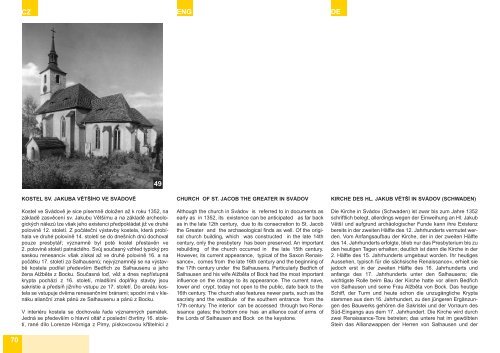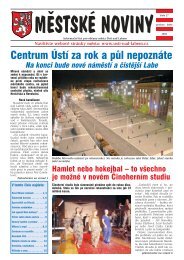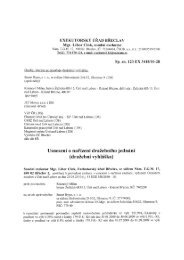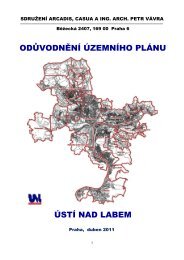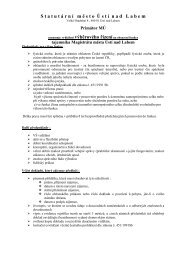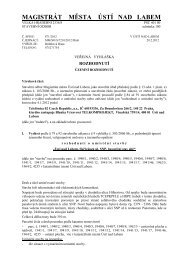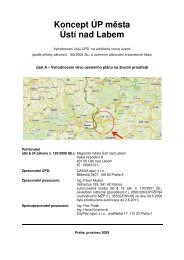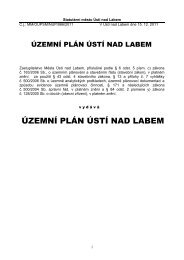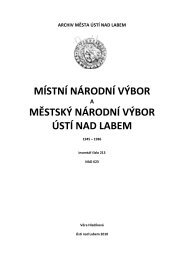Historie a památky města Ústí nad Labem History and monuments of ...
Historie a památky města Ústí nad Labem History and monuments of ...
Historie a památky města Ústí nad Labem History and monuments of ...
Sie wollen auch ein ePaper? Erhöhen Sie die Reichweite Ihrer Titel.
YUMPU macht aus Druck-PDFs automatisch weboptimierte ePaper, die Google liebt.
70<br />
CZ ENG DE<br />
KOSTEL SV. JAKUBA VĚTŠÍHO VE SVÁDOVĚ<br />
46 49<br />
Kostel ve Svádově je sice písemně doložen až k roku 1352, na<br />
základě zasvěcení sv. Jakubu Většímu a na základě archeologických<br />
nálezů lze však jeho existenci předpokládat již ve druhé<br />
polovině 12. století. Z počáteční výstavby kostela, která probíhala<br />
ve druhé polovině 14. století se do dnešních dnů dochoval<br />
pouze presbytář; významně byl poté kostel přestavěn ve<br />
2. polovině století patnáctého. Svůj současný vzhled typický pro<br />
saskou renesanci« však získal až ve druhé polovině 16. a na<br />
počátku 17. století za Salhausenů; nejvýznamněji se na výstavbě<br />
kostela podílel především Bedřich ze Salhausenu a jeho<br />
žena Alžběta z Bocku. Současná loď, věž a dnes nepřístupná<br />
krypta pochází z 16. století, mladšími doplňky stavby jsou<br />
sakristie a předsíň jižního vstupu ze 17. století. Do areálu kostela<br />
se vstupuje dvěma renesančními bránami; spodní má v klenáku<br />
alianční znak pánů ze Salhausenu a pánů z Bocku.<br />
V interiéru kostela se dochovala řada významných památek.<br />
Jedná se především o hlavní oltář z poslední čtvrtiny 16. století,<br />
rané dílo Lorenze Hörniga z Pirny, pískovcovou křtitelnici z<br />
CHURCH OF ST. JACOB THE GREATER IN SVÁDOV<br />
Although the church in Svádov is referred to in documents as<br />
early as in 1352, its existence can be anticipated as far back<br />
as in the late 12th century, due to its consecration to St. Jacob<br />
the Greater <strong>and</strong> the archaeological finds as well. Of the original<br />
church building, which was constructed in the late 14th<br />
century, only the presbytery has been preserved. An important<br />
rebuilding <strong>of</strong> the church occurred in the late 15th century.<br />
However, its current appearance, typical <strong>of</strong> the Saxon Renaissance«,<br />
comes from the late 16th century <strong>and</strong> the beginning <strong>of</strong><br />
the 17th century under the Salhausens. Particularly Bedřich <strong>of</strong><br />
Salhausen <strong>and</strong> his wife Alžběta <strong>of</strong> Bock had the most important<br />
influence on the change to its appearance. The current nave,<br />
tower <strong>and</strong> crypt, today not open to the public, date back to the<br />
16th century. The church also features newer parts, such as the<br />
sacristy <strong>and</strong> the vestibule <strong>of</strong> the southern entrance from the<br />
17th century. The interior can be accessed through two Renaissance<br />
gates; the bottom one has an alliance coat <strong>of</strong> arms <strong>of</strong><br />
the Lords <strong>of</strong> Salhausen <strong>and</strong> Bock on the keystone.<br />
KIRCHE DES HL. JAKUB VĚTŠÍ IN SVÁDOV (SCHWADEN)<br />
Die Kirche in Svádov (Schwaden) ist zwar bis zum Jahre 1352<br />
schriftlich belegt, allerdings wegen der Einweihung an Hl. Jakub<br />
Větší und aufgrund archäologischer Funde kann ihre Existenz<br />
bereits in der zweiten Hälfte des 12. Jahrhunderts vermutet werden.<br />
Vom Anfangsaufbau der Kirche, der in der zweiten Hälfte<br />
des 14. Jahrhunderts erfolgte, blieb nur das Presbyterium bis zu<br />
den heutigen Tagen erhalten; deutlich ist dann die Kirche in der<br />
2. Hälfte des 15. Jahrhunderts umgebaut worden. Ihr heutiges<br />
Aussehen, typisch für die sächsische Renaissance«, erhielt sie<br />
jedoch erst in der zweiten Hälfte des 16. Jahrhunderts und<br />
anfangs des 17. Jahrhunderts unter den Salhausens; die<br />
wichtigste Rolle beim Bau der Kirche hatte vor allem Bedřich<br />
von Salhausen und seine Frau Alžběta von Bock. Das heutige<br />
Schiff, der Turm und heute schon die unzugängliche Krypta<br />
stammen aus dem 16. Jahrhundert, zu den jüngeren Ergänzungen<br />
des Bauwerks gehören die Sakristei und der Vorraum des<br />
Süd-Eingangs aus dem 17. Jahrhundert. Die Kirche wird durch<br />
zwei Renaissance-Tore betreten; das untere hat im gewölbten<br />
Stein das Allianzwappen der Herren von Salhausen und der


